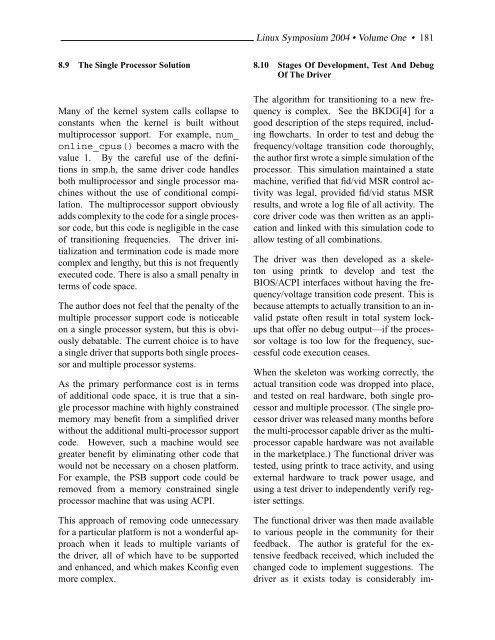Create successful ePaper yourself
Turn your PDF publications into a flip-book with our unique Google optimized e-Paper software.
<strong>Linux</strong> Symposium 2004 • Volume <strong>One</strong> • 181<br />
8.9 <strong>The</strong> Single Processor Solution<br />
Many of the kernel system calls collapse to<br />
constants when the kernel is built without<br />
multiprocessor support. For example, num_<br />
online_cpus() becomes a macro with the<br />
value 1. By the careful use of the definitions<br />
in smp.h, the same driver code handles<br />
both multiprocessor and single processor machines<br />
without the use of conditional compilation.<br />
<strong>The</strong> multiprocessor support obviously<br />
adds complexity to the code for a single processor<br />
code, but this code is negligible in the case<br />
of transitioning frequencies. <strong>The</strong> driver initialization<br />
and termination code is made more<br />
complex and lengthy, but this is not frequently<br />
executed code. <strong>The</strong>re is also a small penalty in<br />
terms of code space.<br />
<strong>The</strong> author does not feel that the penalty of the<br />
multiple processor support code is noticeable<br />
on a single processor system, but this is obviously<br />
debatable. <strong>The</strong> current choice is to have<br />
a single driver that supports both single processor<br />
and multiple processor systems.<br />
As the primary performance cost is in terms<br />
of additional code space, it is true that a single<br />
processor machine with highly constrained<br />
memory may benefit from a simplified driver<br />
without the additional multi-processor support<br />
code. However, such a machine would see<br />
greater benefit by eliminating other code that<br />
would not be necessary on a chosen platform.<br />
For example, the PSB support code could be<br />
removed from a memory constrained single<br />
processor machine that was using ACPI.<br />
This approach of removing code unnecessary<br />
for a particular platform is not a wonderful approach<br />
when it leads to multiple variants of<br />
the driver, all of which have to be supported<br />
and enhanced, and which makes Kconfig even<br />
more complex.<br />
8.10 Stages Of Development, Test And Debug<br />
Of <strong>The</strong> Driver<br />
<strong>The</strong> algorithm for transitioning to a new frequency<br />
is complex. See the BKDG[4] for a<br />
good description of the steps required, including<br />
flowcharts. In order to test and debug the<br />
frequency/voltage transition code thoroughly,<br />
the author first wrote a simple simulation of the<br />
processor. This simulation maintained a state<br />
machine, verified that fid/vid MSR control activity<br />
was legal, provided fid/vid status MSR<br />
results, and wrote a log file of all activity. <strong>The</strong><br />
core driver code was then written as an application<br />
and linked with this simulation code to<br />
allow testing of all combinations.<br />
<strong>The</strong> driver was then developed as a skeleton<br />
using printk to develop and test the<br />
BIOS/ACPI interfaces without having the frequency/voltage<br />
transition code present. This is<br />
because attempts to actually transition to an invalid<br />
pstate often result in total system lockups<br />
that offer no debug output—if the processor<br />
voltage is too low for the frequency, successful<br />
code execution ceases.<br />
When the skeleton was working correctly, the<br />
actual transition code was dropped into place,<br />
and tested on real hardware, both single processor<br />
and multiple processor. (<strong>The</strong> single processor<br />
driver was released many months before<br />
the multi-processor capable driver as the multiprocessor<br />
capable hardware was not available<br />
in the marketplace.) <strong>The</strong> functional driver was<br />
tested, using printk to trace activity, and using<br />
external hardware to track power usage, and<br />
using a test driver to independently verify register<br />
settings.<br />
<strong>The</strong> functional driver was then made available<br />
to various people in the community for their<br />
feedback. <strong>The</strong> author is grateful for the extensive<br />
feedback received, which included the<br />
changed code to implement suggestions. <strong>The</strong><br />
driver as it exists today is considerably im-

















